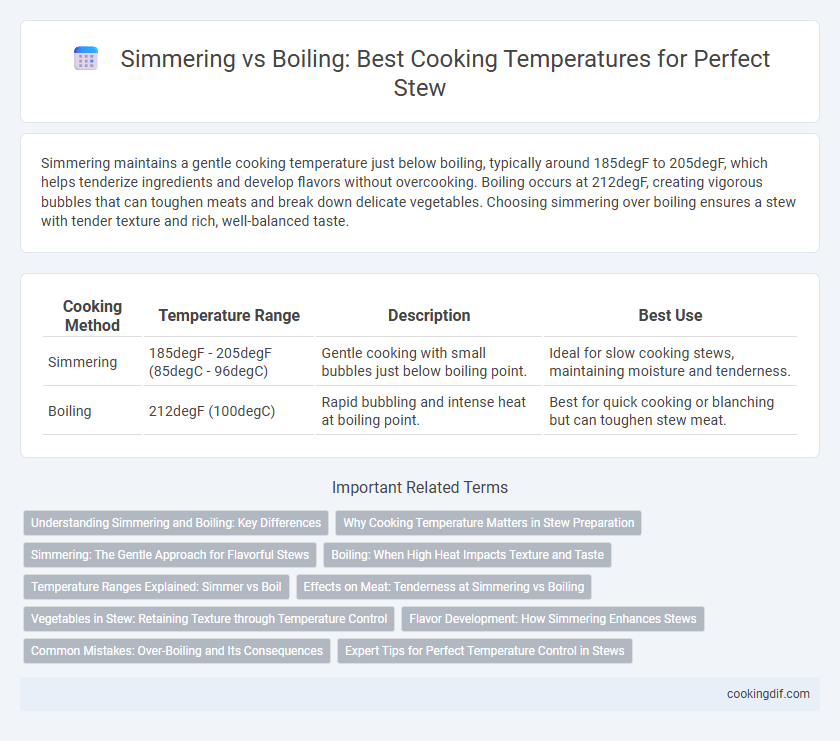Simmering maintains a gentle cooking temperature just below boiling, typically around 185degF to 205degF, which helps tenderize ingredients and develop flavors without overcooking. Boiling occurs at 212degF, creating vigorous bubbles that can toughen meats and break down delicate vegetables. Choosing simmering over boiling ensures a stew with tender texture and rich, well-balanced taste.
Table of Comparison
| Cooking Method | Temperature Range | Description | Best Use |
|---|---|---|---|
| Simmering | 185degF - 205degF (85degC - 96degC) | Gentle cooking with small bubbles just below boiling point. | Ideal for slow cooking stews, maintaining moisture and tenderness. |
| Boiling | 212degF (100degC) | Rapid bubbling and intense heat at boiling point. | Best for quick cooking or blanching but can toughen stew meat. |
Understanding Simmering and Boiling: Key Differences
Simmering occurs at a lower temperature, around 185-205degF (85-96degC), producing gentle bubbles that break the surface slowly, ideal for slow cooking stews to tenderize ingredients without toughening them. Boiling reaches 212degF (100degC), creating rapid, vigorous bubbles that can cause delicate stew components to break apart or toughen. Understanding these temperature differences ensures precise control over stew texture and flavor development during cooking.
Why Cooking Temperature Matters in Stew Preparation
Cooking temperature significantly impacts the texture and flavor development in stew preparation, as simmering at around 185-205degF (85-96degC) allows collagen in tough meat cuts to break down slowly, resulting in tender, juicy pieces. Boiling, typically above 212degF (100degC), agitates ingredients vigorously, which can toughen proteins and cause vegetables to disintegrate, leading to a less cohesive stew. Maintaining the proper simmering temperature also enhances the melding of spices and herbs, creating a richer, more balanced flavor profile essential for hearty stews.
Simmering: The Gentle Approach for Flavorful Stews
Simmering maintains a cooking temperature just below boiling, typically between 185degF and 205degF (85degC to 96degC), allowing flavors to meld without breaking down delicate ingredients. This gentle heat ensures tender meat and well-developed, rich stews with enhanced depth and complexity. Unlike rapid boiling, simmering prevents the stew from becoming cloudy and retains the integrity of vegetables and herbs, resulting in a perfectly balanced dish.
Boiling: When High Heat Impacts Texture and Taste
Boiling stew at high heat rapidly breaks down ingredients, causing tough meats to become rubbery and vegetables to lose their structure. The intense temperature often leads to over-extraction of flavors, resulting in a flat or bitter taste. Maintaining a controlled, lower cooking temperature preserves texture and enhances the depth of flavors in a stew.
Temperature Ranges Explained: Simmer vs Boil
Simmering occurs at a temperature range of approximately 185degF to 205degF (85degC to 96degC), where gentle bubbles form slowly and steadily, ideal for tenderizing meats and blending flavors in stews. Boiling reaches temperatures around 212degF (100degC) at sea level, producing rapid, vigorous bubbles that can toughen ingredients and cause liquids to evaporate quickly. Maintaining precise temperature control between simmering and boiling ensures optimal stew texture and flavor development.
Effects on Meat: Tenderness at Simmering vs Boiling
Simmering maintains a gentle, consistent temperature around 185-205degF (85-96degC) that gradually breaks down collagen in meat, resulting in tender, juicy stew. Boiling at 212degF (100degC) causes the meat fibers to contract rapidly, toughening the texture and leading to a less tender outcome. Slow simmering ensures optimal meat softness by preserving moisture and preventing the meat from becoming stringy or dry.
Vegetables in Stew: Retaining Texture through Temperature Control
Simmering vegetables in stew at a temperature between 185degF and 205degF preserves their texture by preventing cell breakdown and overcooking. Boiling at 212degF causes rapid moisture loss and softening, resulting in mushy vegetables and diminished flavor. Maintaining a gentle simmer ensures vegetables remain tender yet firm, enhancing the overall stew quality.
Flavor Development: How Simmering Enhances Stews
Simmering stews at a gentle temperature between 185degF and 205degF allows flavors to meld and deepen without breaking down delicate ingredients, unlike boiling which can cause rapid evaporation and harsh taste development. The slow extraction of collagen and fats during simmering results in a richer, more tender texture that enhances the overall mouthfeel. Maintaining a steady simmer preserves aromatic compounds and balances acidity, elevating the stew's complexity and depth of flavor.
Common Mistakes: Over-Boiling and Its Consequences
Simmering stews maintains a gentle, consistent temperature around 185-205degF (85-96degC), preserving meat tenderness and enhancing flavor development. Over-boiling causes excessive agitation and temperatures above 212degF (100degC), leading to tough, dry meat and cloudy broth due to protein and fat breakdown. Avoiding these common mistakes ensures a rich, well-balanced stew texture and taste.
Expert Tips for Perfect Temperature Control in Stews
Maintaining the ideal temperature between 185degF and 205degF ensures a gentle simmer for stews, promoting tender meat and rich flavors without toughening protein fibers. Boiling at 212degF can break down collagen quickly but risks overcooking and reducing liquid volume excessively, impacting texture and taste. Experts recommend using a heavy-bottomed pot with a tight-fitting lid to stabilize temperature and prevent evaporation, allowing precise control over stew consistency and depth of flavor.
Simmering vs Boiling for cooking temperature Infographic

 cookingdif.com
cookingdif.com